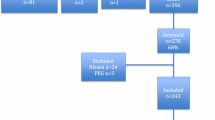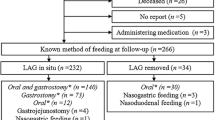Abstract
The objectives of this study were to report our experience with the laparoscopic video-assisted gastrostomy technique in infants operated during their first year of life. A total of 53 infants (35 males, 18 females) aged 6±3 months, varying from 3 weeks to 11 months, underwent video-assisted gastrostomy. They were prospectively followed up. Included are infants with neurological dysfunction, chromosomal anomalies, metabolic disorders, cardiac anomalies or respiratory insufficiency. All the infants were operated under general and local anaesthesia. Gastrostomy tube feeding began within 4 h after the operation. The infants were followed with a scheduled control at 1 and 6 months postoperatively documenting complications and weight gain. The main outcome measure was the number and type of complications as well as weight gain using the age-adjusted Z-score of weight to normalize the data relative to a reference population. The weight before and 6 months after the video-assisted gastrostomy was 5.5±1.6 and 8.5±1.6 kg, respectively. The Z-score increased significantly (P<0.001) from −2.7±1.5 to −1.7±1.0. This illustrates the postoperative weight gain and catch-up. Short and long-term complications included minor local wound infection, leakage around the gastrostomy tube and granuloma, but no severe complications. Our results encourage the use of video-assisted gastrostomy as a safe technique to provide a route for long-term nutritional support even in infants less than 1 year.
Similar content being viewed by others
References
Fanelli RD, Ponsky JL (1992) A simplified technique for percutaneous endoscopic gastrostomy. Surg Endosc 6:261–262
Gauderer MW, Ponsky JL, Izant RJ Jr (1998) Gastrostomy without laparotomy: a percutaneous endoscopic technique. Nutrition 14:736–738
Andersson L, Mikaelsson C, Arnbjornsson E et al (1997) Laparoscopy aided gastrostomy in children. Ann Chir Gynaecol 86:19–22
Georgeson KE (1993) Laparoscopic gastrostomy and fundoplication. Pediatr Ann 22:675–677
Kellnar ST, Till H, Bohn R (1999) Laparoscopically assisted performance of gastrostomy—a simple, safe and minimal invasive technique. Eur J Pediatr Surg 9:297–298
Rothenberg SS, Bealer JF, Chang JH (1999) Primary laparoscopic placement of gastrostomy buttons for feeding tubes. A safer and simpler technique. Surg Endosc 13:995–997
Tomicic JT, Luks FI, Shalon L et al (2002) Laparoscopic gastrostomy in infants and children. Eur J Pediatr Surg 12:107–110
Khattak IU, Kimber C, Kiely EM et al (1998) Percutaneous endoscopic gastrostomy in paediatric practice: complications and outcome. J Pediatr Surg 33:67–72
Larson DE, Burton DD, Schroeder KW et al (1987) Percutaneous endoscopic gastrostomy. Indications, success, complications, and mortality in 314 consecutive patients. Gastroenterology 93:48–52
Patwardhan N, McHugh K, Drake D, Spitz L (2004) Gastroenteric fistula complicating percutaneous endoscopic gastrostomy. J Pediatr Surg 39:561–564
Arnbjornsson E, Larsson LT, Lindhagen T (1999) Complications of laparoscopy-aided gastrostomies in pediatric practice. J Pediatr Surg 34:1843–1846
Liou TG, Adler FR, Fitzsimmons SC et al (2001) Predictive 5-year survivorship model of cystic fibrosis. Am J Epidemiol 53:345–352
Albertsson-Wikland K, Karlberg J (1994) Natural growth in children born small for gestational age with and without catch-up growth. Acta Paediatr Suppl 399:64–70
Behrens R, Lang T, Muschweck H et al (1997) Percutaneous endoscopic gastrostomy in children and adolescents. J Pediatr Gastroenterol Nutr 25:487–491
Norton B, Homer-Ward M, Donnelly MT et al (1996) A randomised prospective comparison of percutaneous endoscopic gastrostomy and nasogastric tube feeding after acute dysphagic stroke. BMJ 312:13–16
Haynes L, Atherton DJ, Ade-Ajayi N et al (1996) Gastrostomy and growth in dystrophic epidermolysis bullosa. Br J Dermatol 134:872–879
Heine RG, Reddihough DS, Catto-Smith AG (1995) Gastro-oesophageal reflux and feeding problems after gastrostomy in children with severe neurological impairment. Dev Med Child Neurol 37:320–329
Chang PF, Ni YH, Chang MH (2003) Percutaneous endoscopic gastrostomy to set up a long-term enteral feeding route in children: an encouraging result. Pediatr Surg Int 19:283–285
Gauderer MW (1991) Percutaneous endoscopic gastrostomy: a 10-year experience with 220 children. J Pediatr Surg 26:288–292
Grant JP (1988) Comparison of percutaneous endoscopic gastrostomy with Stamm gastrostomy. Ann Surg 207:598–603
Haws EB, Sieber WK, Kiesewetter WB (1966) Complications of tube gastrostomy in infants and children. 15-year review of 240 cases. Ann Surg 164:284–290
Hogan RB, DeMarco DC, Hamilton JK et al (1986) Percutaneous endoscopic gastrostomy—to push or pull. A prospective randomized trial. Gastrointest Endosc 32:253–258
Kimber CP, Khattak IU, Kiely EM et al (1998) Peritonitis following percutaneous gastrostomy in children: management guidelines. Aust NZ J Surg 68:268–270
Marin OE, Glassman MS, Schoen BT et al (1994) Safety and efficacy of percutaneous endoscopic gastrostomy in children. Am J Gastroenterol 89:357–361
Acknowledgement
The authors are grateful to Håkan Lövkvist, Statistician, Competence Centre for Clinical Research, Lund University Hospital, SE-221 85 Lund, Sweden, for statistical advice.
Author information
Authors and Affiliations
Corresponding author
Rights and permissions
About this article
Cite this article
Backman, T., Arnbjörnsson, E., Berglund, Y. et al. Video-assisted gastrostomy in infants less than 1 year. Ped Surgery Int 22, 243–246 (2006). https://doi.org/10.1007/s00383-005-1628-x
Accepted:
Published:
Issue Date:
DOI: https://doi.org/10.1007/s00383-005-1628-x




